When/Where Are We?
An Overview
By Nicholas Hoffman
This first unit in English 2201 covers what is generally called the pre-Conquest period. We will be reading about the literature and culture of the British Isles during a formative historical era: from the withdrawal of Roman troops in the 5th century to the eve of William the Conquerer’s invasion of the island in 1066.
It’s important to remember that this timeline encompasses a period of over 600 years! During the Migration Period, Germanic settlers and mercenaries from present-day central Europe gradually displaced, influenced, and melded with the peoples and cultures of Roman Britain (ca. 400-500). The 7th and 8th centuries then witnessed the Christianization of early medieval England and the growth of a thriving literary-monastic culture. And we can’t forget the Vikings, whose raiding and trading practices brought a large swathe of England under Scandinavian control in a region known as the Danelaw.
Of all the religious, social, and political developments of early medieval England, perhaps the most significant (for the purposes of this course) is the growth of a vernacular literature. Texts were recorded in the earliest form of the English language (Old English) alongside texts in the international standard of scholarship, Latin. Not to be confused with the English of Shakespeare or even Chaucer, Old English retains the Germanic character of the island’s early medieval settlers and requires study in order to learn its ins and outs. In this unit, you will have the opportunity to engage with Old English texts in translation to gain a better understanding of early English literary achievement — and hopefully come to appreciate its monumental creativity. Check out the video below to learn a little more about Old English and its distinction from Modern English!
Mastery Check:
- Did Shakespeare write in Old English?
- What language was the “international benchmark” (or lingua franca) in medieval Western Europe?
- How did the English alphabet of circa 1000 differ from our own?
- The surviving corpus of Old English poetry survives in how many manuscripts?
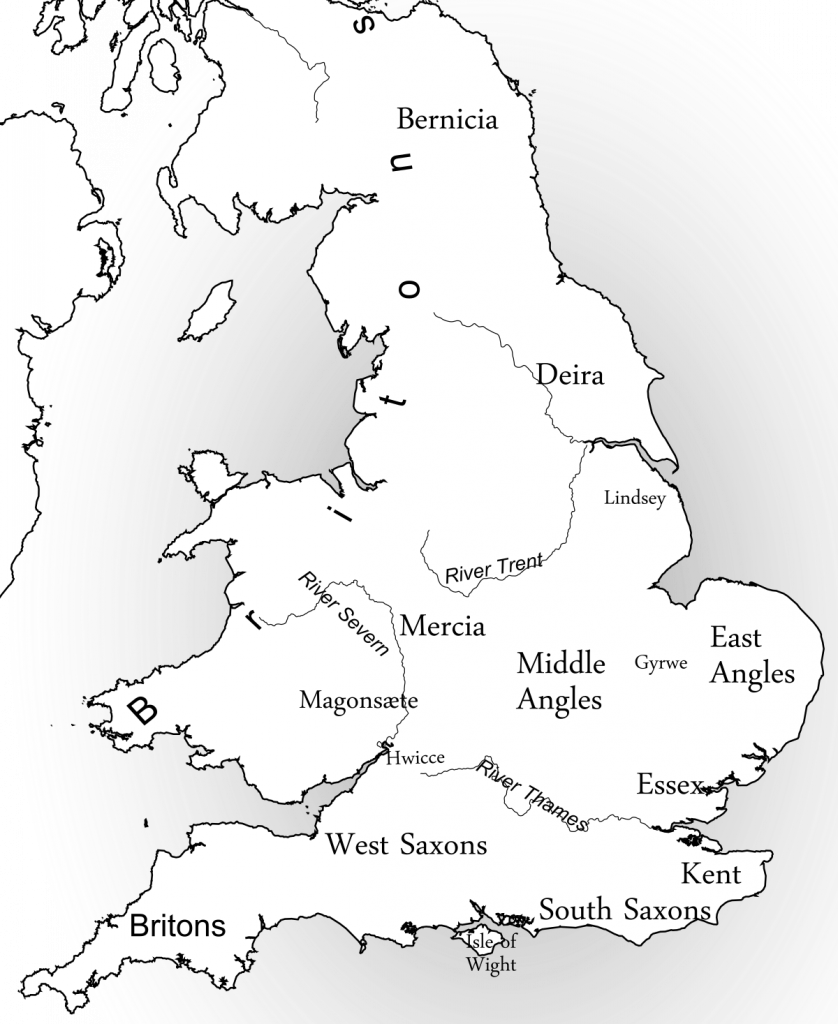
Cartography is key!
Take a look at the map above. The image gives a rough impression of the various kingdoms in existence during the 7th century. The seven main kingdoms during the pre-Conquest period are sometimes referred to as the Heptarchy (literally “seven realms” in Greek). These kingdoms dominated religious and secular life in medieval Britain prior to the Norman Conquest in 1066.
At the edges of the Heptarchy were the native Britons, pushed into Wales and Northern Scotland during the Migration Period. They retained much of their native Celtic languages and customs, including religious organization and literary traditions. Native British (i.e., “Briton”) customs and institutions would greatly influence the development of political and literary culture in the Heptarchy, as would the later Viking incursions. The historical formation of the Heptarchy is a story of dynamic change and cultural exchange.
See if you can locate and familiarize yourself with the seven kingdoms of pre-Conquest England:
- Mercia
- East Anglia
- Kent
- Northumbria (formerly Deira + Bernicia)
- Essex (“East” + “Saxons” = “Essex”)
- Sussex (“South” + “Saxons” = “Sussex”)
- Wessex (“West” + “Saxons” = “Wessex”)
Why do you think this period of English history has traditionally been called “Anglo-Saxon England”? What does the name “Anglo-Saxon England” imply?
The Diverse Early Middle Ages
As we reach back to the origins of English literary history, we expect to find a strange world—an unintelligible language, truly peculiar manuscript pages, a society frozen in time. To many of our imaginations, the early Middle Ages (ca. 500–1066 CE) was a time of silent monks and loud warriors cohabiting a secluded island on the northwest edge of Europe. Historically dubbed the“Dark Ages,” we’ve been conditioned to expect a simpler way of life over these centuries. Our minds wander to scenes of blood feuds played out against a pastoral backdrop, where people neither questioned their views nor knew much at all about the wider, multi-cultural globe.
But these assumptions speak more to contemporary (and often violent) ideology than historical reality. In fact, centuries of romanticized thinking have created this notion that early medieval England was a bulwark of uncritical Christianity and isolationism. You are embarking on English 2201 at an exciting (and often painful) time in medieval studies; scholars are now actively pushing against some long-held assumptions about the early Middle Ages—specifically that it was uniform and uncritical in its Christianity, that it was solely white, and that it was disconnected from a diverse world.
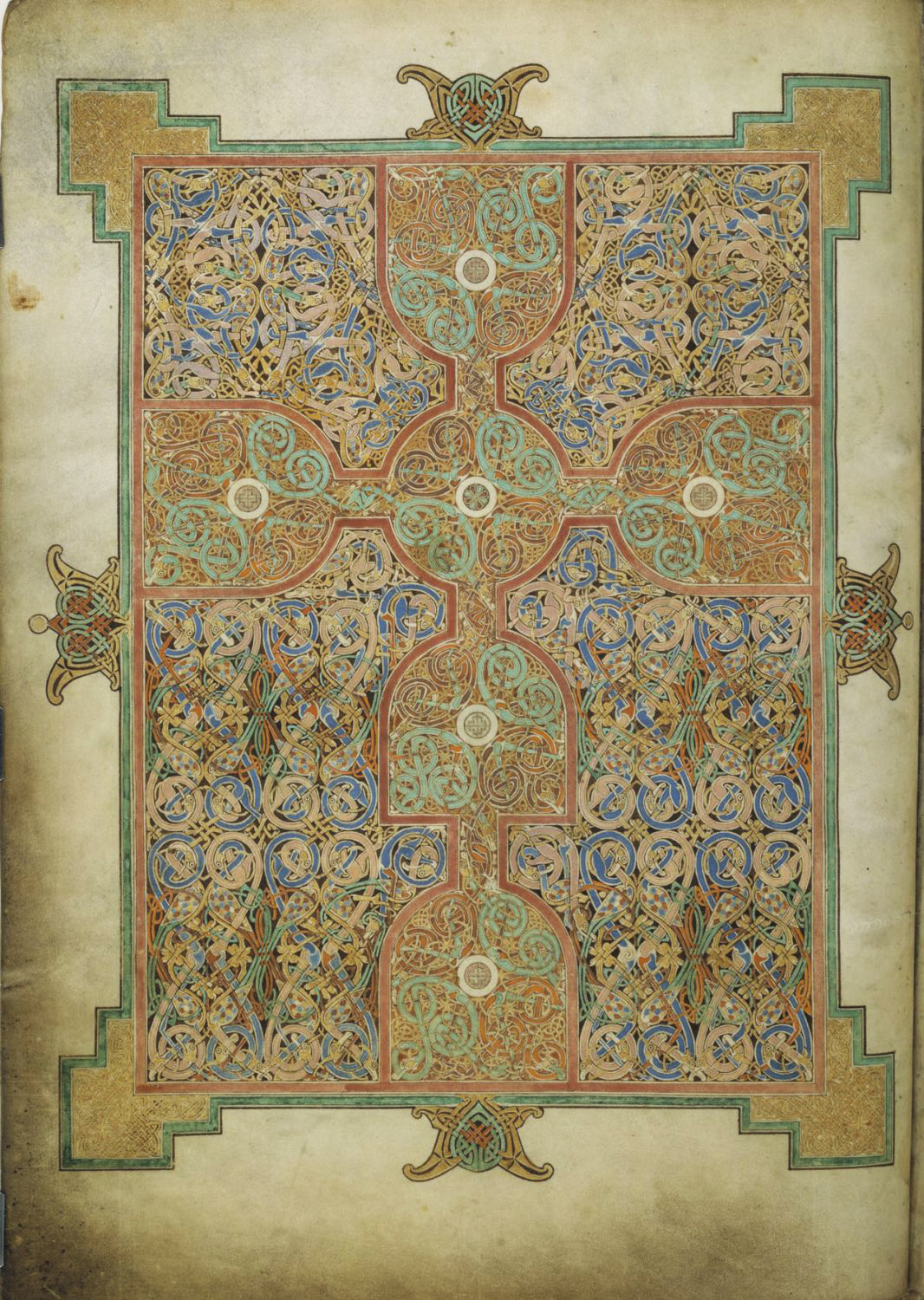
Writing from the Periphery
Above is an image from the Lindisfarne Gospels (folio 26 verso). Completed sometime in the early 8th century, this book features elaborate “carpet pages,” complete with intricate, interwoven designs. In this unit, you’ll encounter the Book of Kells, which shares in this early “interlace” tradition and its fascination with arresting, geometric designs. Evidence of these woven patterns can be found across present-day Ireland, Scotland, and Northern England. They also appear across early medieval media, from manuscript pages to metalwork and stone carving. This labor required phenomenal artistic skill, while simultaneously revealing a keen interest in geometry, symmetry, and the power of abstract shapes and orientations to deliver a divine message.[1]
These forms are all about interconnectivity: these interlace patterns can be found throughout the northern isles, and the designs are a testament to both religious devotion and the everyday, textile work that formed a staple of the early medieval economy.
Paradoxically, the interwoven art of the Lindisfarne Gospels was produced in a monastery marked by geographic isolation. The island of Lindisfarne is located off the northeast coast of England and can only be accessed on foot during low tide. But sometimes geography is deceiving: Lindisfarne, though isolated, was part of a thriving monastic network. The monastery housed visitors and jump-started the careers of several of the most important religious leaders of its day. Not to mention, the Lindisfarne Gospels themselves show how intertwined this tide-washed island was with the artistic tastes of the wider world.
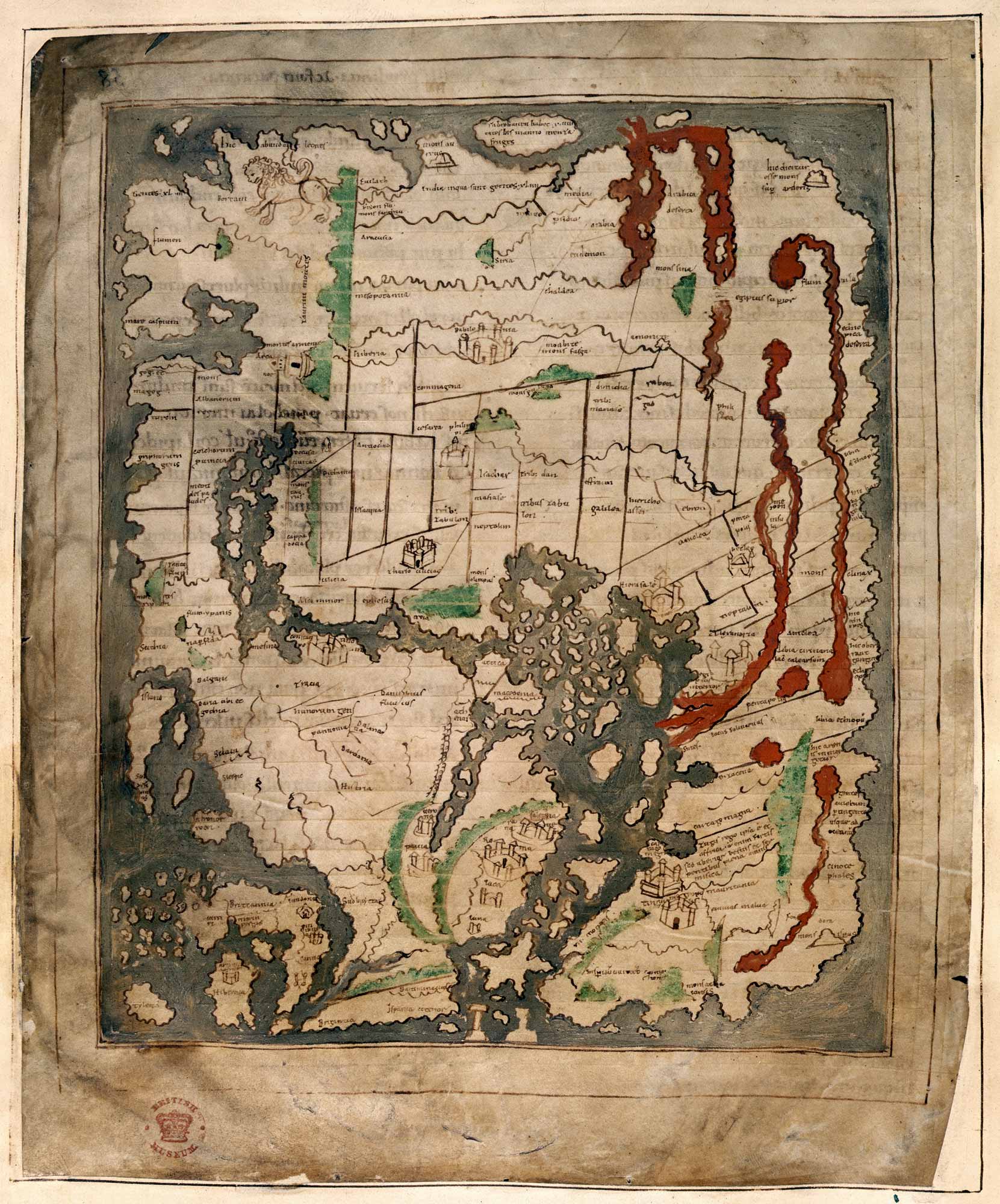
But early English engagement with the “outside” didn’t end with the North Atlantic. Just look at the image above: a mappa mundi (“map of the world”) surviving in one manuscript from the early 11th century (Cotton MS Tiberius BV). It is the earliest known cartographic depiction of the British Isles—but not in the area of the map you would expect them! England and Ireland can be found in the bottom left corner, on the edge of a vast world connected by roads and waterways. The map includes major cities, travel routes, a Mediterranean sea populated with numerous islands, settings of biblical importance, and even a fantastic creature lurking on the periphery. Though agrarian life inhabited the center of many communities, early medieval writers and thinkers were aware of their place in a vast, interconnected world.
Material History and Identity
The early English had access to a wide array of material goods—many of their own making but others imported from further reaches of the Mediterranean world and beyond. The archaeological record shows evidence of thriving trade networks: Scandinavian metalwork, various textiles, including valuable silk, and books from present-day Italy, France, and Germany.
The interlace work discussed above is evidence of English engagement with North Atlantic art styles. At the same time, manuscript illustrators and material artisans drew inspiration from even further afield. Ornate brooches were made in Danish or Swedish style. Scribes developed their own unique scripts based on outside models. Illustrators learned new forms from the continent. Not only were they avid imitators and innovators of this art, but the early English themselves traveled widely.
Another excellent example of English cultural borrowing is pictured below. The image shows a coin (a dinar, to be specific) from the reign of King Offa (ca. 774–796). It mimics the design and even the Arabic script of the Abassid ruler, caliph al-Mansur. It’s a remarkable piece of material history; Offa found in his coinage a way of tapping into the prestige of the Islamic Empire on the other side of the known world.
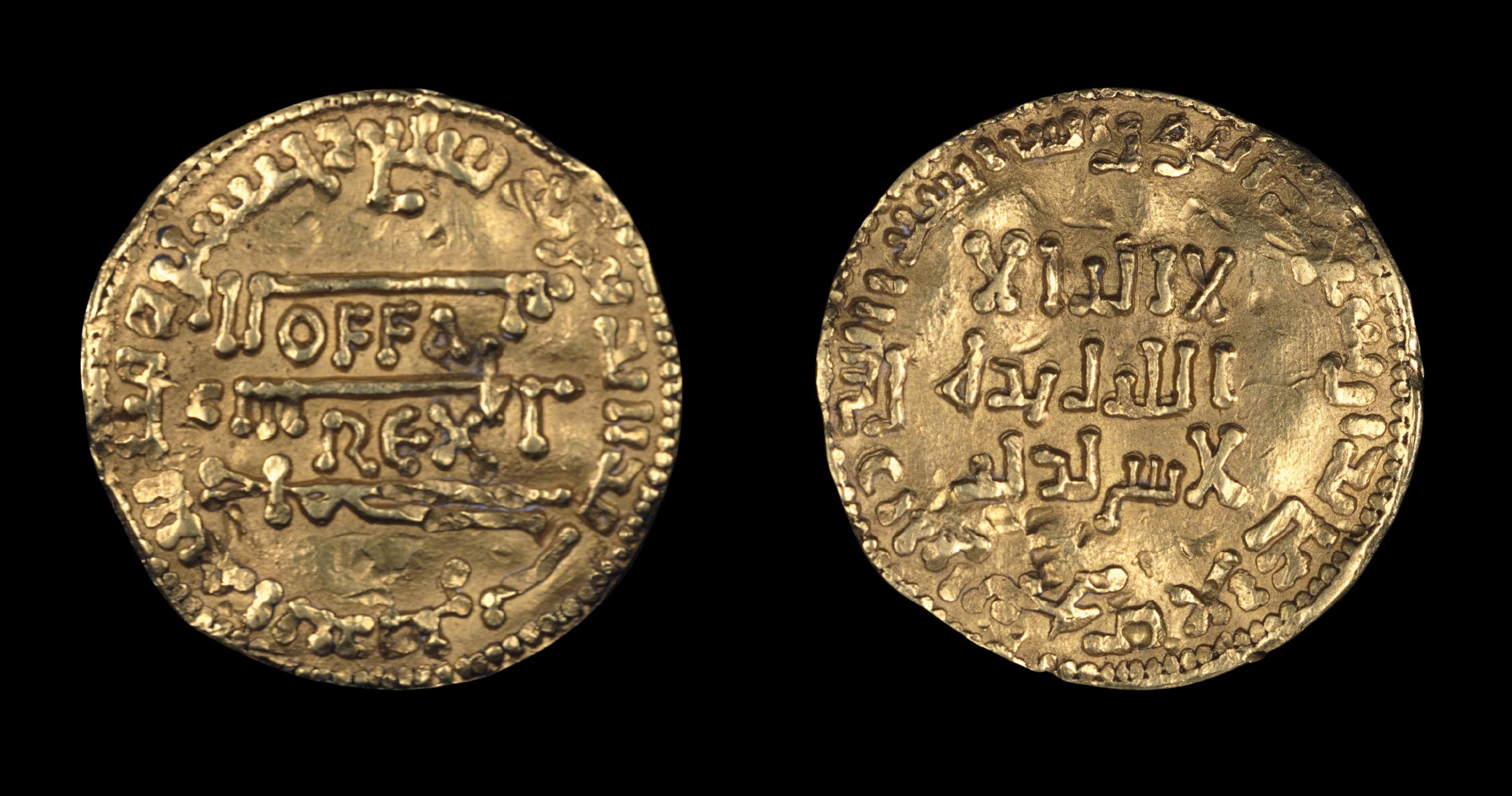
Offa’s coin serves as a powerful reminder that the English, even in the earliest part of the Middle Ages, were aware of and keenly interested in their place in a wider world. Old English writers were particularly interested in exploring far-off settings. The surviving poetry features biblical re-tellings and narratives of saints’ lives that take place in Asia and North Africa. More to the point: people of African descent had been present in England since Roman times.
One prose text in particular, The Wonders of the East, is contained in three manuscripts (including the same manuscript in which the single copy of Beowulf survives). The Wonders is a richly illustrated catalogue of, well, “wonders.” The text describes far-off landscapes with supernatural properties, sometimes inhabited by strange, even monstrous, creatures. The Panotti, for example, were rumored to possess ears long enough to cover their whole bodies.
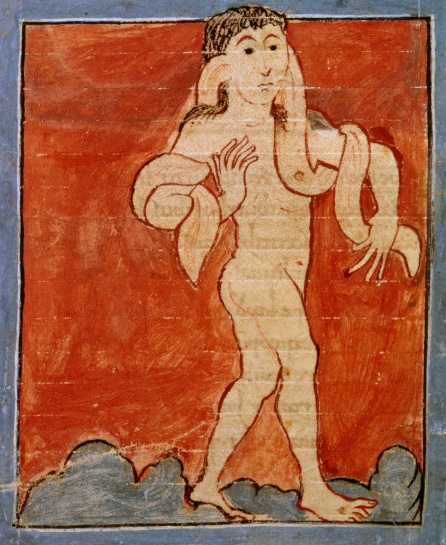
If we refer back to the “map of the world” above, we see that early English writers and cartographers saw no issue with blurring the distinction between the human and the monstrous in their depictions of unfamiliar parts of the world. The Wonders and other texts that reveal early medieval attitudes toward the “foreign” and the “exotic” are of incredible value to scholars attempting to make sense of early medieval understandings of race and racism(s).
Multicultural Canterbury
In late May of 669, at the age of 68, Theodore of Tarsus (d. 690) made landfall on the southeast shores of England. The 1000-mile journey from Rome was a long and arduous one, and he was expected to meet with secular and religious leaders on the continent along the way. His task from Pope Vitalian: take up the archbishopric of Canterbury (a high-profile administrative role in the Church).
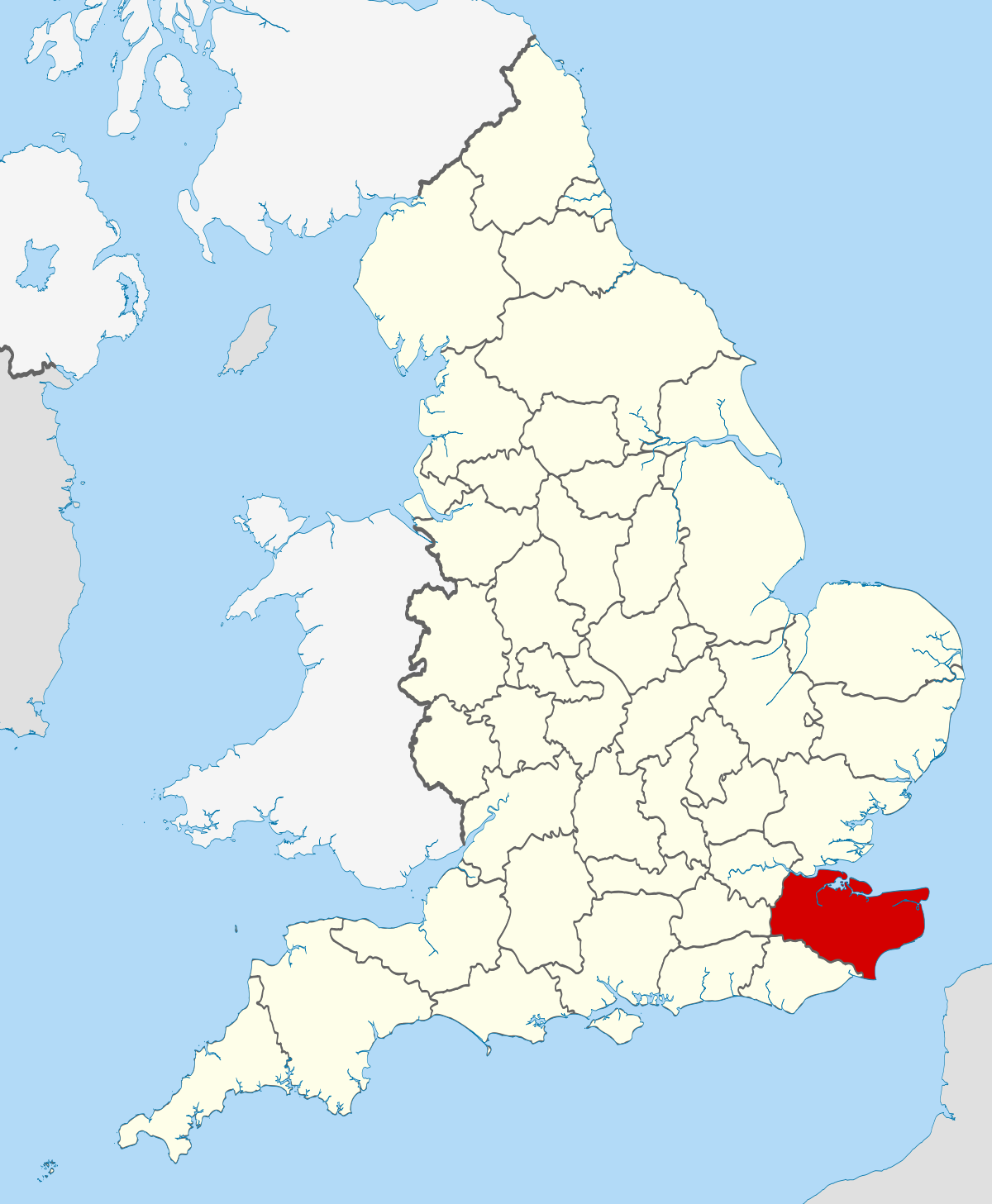
As his name suggests, Theodore was born in Tarsus, a city in present-day Turkey. He was a Byzantine Greek, and during his childhood he witnessed the conquest of Tarsus by Persian forces. He was also familiar with the neighboring Syrian culture and witnessed the spread of Islam. He attained a high level of education in his native Greek but also Latin. He studied law, philosophy, medicine, and biblical interpretation, among other things.
Theodore was not the only religious figure to be “outsourced” from the continent to early medieval England. As Christianity and Church institutions were expanding on the British Isles, Rome supplied officials from across its pan-Mediterranean network to oversee the young English dioceses. And Theodore didn’t come to England alone; he was joined by Hadrian (d. 710), who was traveling to England to continue his monastic career. Like Theodore, Hadrian was studious and respected as a theologian and thinker. He too was a long way from home: he was North African by birth and bilingual in Greek and Latin.[2]
Theodore and Hadrian cooperatively founded a school at Canterbury where monks were trained in all manner of religious and secular learning. Monasteries were already multilingual spaces; training in Latin was an asset, since liturgy and religious texts were most often transmitted in the lingua franca of the day. Competency in Latin meant access to a whole world of textual information as well as a wider audience for one’s own writing. It was under the instruction of Hadrian that Aldhelm (d. 709) became the first English poet to compose Latin verse.
Much of what we know about Theodore and Hadrian comes from the writings of Bede (d. 735). In his Ecclesiastical History, Bede sought to offer a comprehensive history of Christianity in England, and the figures of Theodore and Hadrian stand out as particularly important in the development of monastic learning on the island.[3] Writing from the northern reaches of England, Bede felt the pull of their intellectual orbits. Perplexingly, Theodore and Hadrian left behind no written works of their own. Instead, their presence survives in the work of their students, particularly the class notes, poetry, and biblical commentaries that survive from their Canterbury school.
The collective efforts of Theodore and Hadrian invigorated monastic learning in England. They were valuable resources for an intellectual culture that was seeking to establish itself. Since they presumably arrived in England without any significant knowledge of Old English, training with them required a high level of Latin ability. They introduced academic teachings and new concepts while offering practical training in Church administration and the monastic way of life. Perhaps more significantly, they shared their experiential knowledge. Theodore and Hadrian had seen much of the world and encountered many cultures. We can’t discount the profound impact such narratives may have had on their students.
The remarkable lives of Theodore and Hadrian have much to teach us about the diversity of early medieval England. From its very foundations, we can think globally and multiculturally about the history of English literature.
Mastery Check:
- What views of early medieval England are scholars today pushing back against?
- True or False: What we know today as England was in the seventh century composed of distinct kingdoms.
- What do we call the design tradition found everywhere in early art–from manuscript pages to belt buckles?
- Where do you find England and Ireland in the eleventh-century Mappa Mundi?
- How early were people of African descent present in Britain?
- Who were Hadrian and Theodore of Tarsus, and why were they important?
- For those interested in early medieval material art and the history and potential rationale behind these patterns, I’ve been enjoying Derek Hull’s Celtic and Anglo-Saxon Art: Geometric Aspects (Liverpool UP, 2003). ↵
- For more on Hadrian’s life, see “An African Abbot in Anglo-Saxon England,” British Library, 27 October 2016, https://blogs.bl.uk/digitisedmanuscripts/2016/10/an-african-abbot-in-anglo-saxon-england.html. ↵
- You can read the section of the Ecclesiastical History about their arrival here: http://www.gutenberg.org/files/38326/38326-h/38326-h.html#toc187. ↵
Early medieval England, existing from the 5th to the 11th centuries from the end of Roman Britain until the Norman conquest in 1066. It consisted of various Anglo-Saxon kingdoms until 927 when it was united as the Kingdom of England by King Æthelstan (r. 927–939). It became part of the short-lived North Sea Empire of Cnut the Great, a personal union between England, Denmark and Norway in the 11th century. (source: Wikipedia)
A period that lasted from AD 375 (possibly as early as 300) to 568, during which there were widespread invasions of peoples within or into Europe, during and after the decline of the Western Roman Empire, mostly into Roman territory, notably the Germanic tribes and the Huns. (source: Wikipedia)
Latin: Britannia or, later, Britanniae, "the Britains". Roman Britain was the area of the island of Great Britain that was governed by the Roman Empire, from 43 to 410 AD. It comprised almost the whole of England and Wales and, for a short period, southern Scotland. (source: Wikipedia)
The Christianisation of Anglo-Saxon England was a process spanning the 7th century. It was essentially the result of the Gregorian mission of 597, which was joined by the efforts of the Hiberno-Scottish mission from the 630s. From the 8th century, the Anglo-Saxon mission was, in turn, instrumental in the conversion of the population of the Frankish Empire.
Æthelberht of Kent was the first king to accept baptism, circa 601. He was followed by Saebert of Essex and Rædwald of East Anglia in 604. However, when Æthelberht and Saebert died, in 616, they were both succeeded by pagan sons who were hostile to Christianity and drove the missionaries out, encouraging their subjects to return to their native paganism. Christianity only hung on with Rædwald, who was still worshiping the pagan gods alongside Christ. (source: Wikipedia)
The Danelaw (also known as the Danelagh; Old English: Dena lagu; Danish: Danelagen), as recorded in the Anglo-Saxon Chronicle, is a historical name given to the part of England in which the laws of the Danes held sway and dominated those of the Anglo-Saxons. Danelaw contrasts with West Saxon law and Mercian law. The term is first recorded in the early 11th century as Dena lage. Modern historians have extended the term to a geographical designation. The areas that constituted the Danelaw lie in northern and eastern England. (source: Wikipedia)
A language or dialect that is naturally spoken by the people of a particular country or district; native, indigenous. (source: OED)
Old English (Ænglisc, Anglisc, Englisc) is the earliest historical form of the English language, spoken in England and southern and eastern Scotland in the early Middle Ages. It was probably brought to Great Britain by Anglo-Saxon settlers in the mid-5th century, and the first Old English literary works date from the mid-7th century. After the Norman conquest of 1066, English was replaced, for a time, as the language of the upper classes by Anglo-Norman, a relative of French. This is regarded as marking the end of the Old English era, as during this period the English language was heavily influenced by Anglo-Norman, developing into a phase known now as Middle English. (source: Wikipedia)
The heptarchy (Ancient Greek: ἑπτά + ἀρχή, seven + realm) is a collective name applied to seven Anglo-Saxon kingdoms. These were: Northumbria, Mercia, East Anglia, Essex, Kent, Sussex and Wessex. The Anglo-Saxon kingdoms eventually became the Kingdom of England. The term has been in use since the 16th century. (source: Wikipedia)
The Britons (Old English: Brytas), also known as Celtic Britons or Ancient Britons, were Celtic people who inhabited Great Britain from at least the British Iron Age into the Middle Ages, at which point their culture and language diverged into the modern Welsh, Cornish and Bretons (among others). They spoke the Common Brittonic language, the ancestor to the modern Brittonic languages. (source: Wikipedia)
Historians typically regard the Early Middle Ages or Early Medieval Period, sometimes referred to as the Dark Ages, as lasting from the 5th or 6th century to the 10th century. They marked the start of the Middle Ages of European history. The alternative term "Late Antiquity" emphasizes elements of continuity with the Roman Empire, while "Early Middle Ages" is used to emphasize developments characteristic of the earlier medieval period. As such the concept overlaps with Late Antiquity, following the decline of the Western Roman Empire, and precedes the High Middle Ages (c. 11th to 13th centuries). (source: Wikipedia)
The Lindisfarne Gospels (London, British Library Cotton MS Nero D.IV) is an illuminated manuscript gospel book probably produced around the years 715-720 in the monastery at Lindisfarne, off the coast of Northumberland, which is now in the British Library in London. The manuscript is one of the finest works in the unique style of Hiberno-Saxon or Insular art, combining Mediterranean, Anglo-Saxon and Celtic elements. (source: Wikipedia)
Carpet pages are a characteristic feature of Insular illuminated manuscripts. They are pages of mainly geometrical ornamentation, which may include repeated animal forms, typically placed at the beginning of each of the four Gospels in Gospel Books. The designation "carpet page" is used to describe those pages in Christian, Islamic, or Jewish illuminated manuscripts that contain little or no text and which are filled entirely with decorative motifs.
The Book of Kells is an illuminated manuscript Gospel book in Latin, containing the four Gospels of the New Testament together with various prefatory texts and tables. It was created in a Columban monastery in either Britain or Ireland and may have had contributions from various Columban institutions from both Britain and Ireland. It is believed to have been created c. 800 AD. The text of the Gospels is largely drawn from the Vulgate, although it also includes several passages drawn from the earlier versions of the Bible known as the Vetus Latina. It is a masterwork of Western calligraphy and represents the pinnacle of Insular illumination. It is also widely regarded as one of Ireland's finest national treasures. The manuscript takes its name from the Abbey of Kells, which was its home for centuries.
A mappa mundi is any medieval European map of the world. Such maps range in size and complexity from simple schematic maps 25 millimetres (1 inch) or less across to elaborate wall maps, the largest of which was 3.5 m (11 ft 6 in) in diameter. The term derives from the Medieval Latin words mappa (cloth or chart) and mundi (of the world).
Approximately 1,100 mappae mundi are known to have survived from the Middle Ages. Of these some 900 are found illustrating manuscripts and the remainder exist as stand-alone documents. (source: Wikipedia)
The Wonders of the East (or The Marvels of the East) is an Old English prose text, probably written around AD 1000. It is accompanied by many illustrations and appears also in two other manuscripts, in both Latin and Old English. It describes a variety of odd, magical and barbaric creatures that inhabit Eastern regions, such as Babylonia, Persia, Egypt, and India. The Wonders can be found in three extant manuscripts from the 11th and 12th centuries, the earliest of these being the famous Nowell Codex, which is also the only manuscript containing Beowulf. The Old English text was originally translated from a Latin text now referred to as De rebus in Oriente mirabilbus, and remains mostly faithful to the Latin original. (source: Wikipedia)
Theodore of Tarsus (602 – 19 September 690) was Archbishop of Canterbury from 668 to 690. Theodore grew up in Tarsus, but fled to Constantinople after the Persian Empire conquered Tarsus and other cities. After studying there, he relocated to Rome and was later installed as the Archbishop of Canterbury. Accounts of his life appear in two 8th-century texts. Theodore is best known for his reform of the English Church and establishment of a school in Canterbury. (source: Wikipedia)
Adrian, also spelled Hadrian (born before 637, died 710), was an African scholar in Anglo-Saxon England and the abbot of Saint Peter's and Saint Paul's in Canterbury. He was a noted teacher and commentator of the Bible. Adrian was born between 630 and 637. According to Bede, he was a Berber native of North Africa, and abbot of a monastery near Naples, called Monasterium Niridanum (perhaps a mistake for Nisidanum, as being situated on the island of Nisida). (source: Wikipedia)
Canterbury Cathedral in Canterbury, Kent, is one of the oldest and most famous Christian structures in England. It forms part of a World Heritage Site. It is the cathedral of the Archbishop of Canterbury, currently Justin Welby, leader of the Church of England and symbolic leader of the worldwide Anglican Communion. Its formal title is the Cathedral and Metropolitical Church of Christ at Canterbury.
Founded in 597, the cathedral was completely rebuilt between 1070 and 1077. The east end was greatly enlarged at the beginning of the 12th century, and largely rebuilt in the Gothic style following a fire in 1174, with significant eastward extensions to accommodate the flow of pilgrims visiting the shrine of Thomas Becket, the archbishop who was murdered in the cathedral in 1170. The Norman nave and transepts survived until the late 14th century, when they were demolished to make way for the present structures.
Before the English Reformation the cathedral was part of a Benedictine monastic community known as Christ Church, Canterbury, as well as being the seat of the archbishop. (source: Wikipedia)
A lingua franca, also known as a bridge language, common language, trade language, auxiliary language, vehicular language, or link language, is a language or dialect systematically used to make communication possible between groups of people who do not share a native language or dialect, particularly when it is a third language that is distinct from both of the speakers' native languages. (source: Wikipedia)
Aldhelm (c. 639 – 25 May 709), Abbot of Malmesbury Abbey, Bishop of Sherborne, and a writer and scholar of Latin poetry, was born before the middle of the 7th century. (source: Wikipedia)
Bede, also known as Saint Bede, Venerable Bede, and Bede the Venerable (Latin: Bēda Venerābilis), was an English Benedictine monk at the monastery of St. Peter and its companion monastery of St. Paul in the Kingdom of Northumbria of the Angles (contemporarily Monkwearmouth–Jarrow Abbey in Tyne and Wear, England).
Born on lands belonging to the twin monastery of Monkwearmouth-Jarrow in present-day Tyne and Wear, Bede was sent to Monkwearmouth at the age of seven and later joined Abbot Ceolfrith at Jarrow, both of whom survived a plague that struck in 686, an outbreak that killed a majority of the population there. While he spent most of his life in the monastery, Bede travelled to several abbeys and monasteries across the British Isles, even visiting the archbishop of York and King Ceolwulf of Northumbria.
He is well known as an author, teacher (a student of one of his pupils was Alcuin), and scholar, and his most famous work, Ecclesiastical History of the English People, gained him the title "The Father of English History". (source: Wikipedia)
The Ecclesiastical History of the English People (Latin: Historia ecclesiastica gentis Anglorum), written by the Venerable Bede in about AD 731, is a history of the Christian Churches in England, and of England generally; its main focus is on the conflict between the pre-Schism Roman Rite and Celtic Christianity. It was originally composed in Latin, and is considered one of the most important original references on Anglo-Saxon history and has played a key role in the development of an English national identity. It is believed to have been completed in 731 when Bede was approximately 59 years old. (source: Wikipedia)